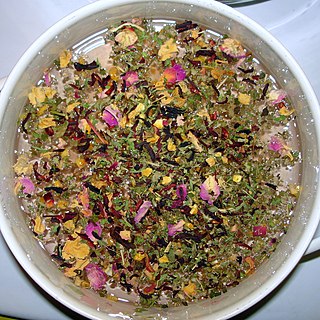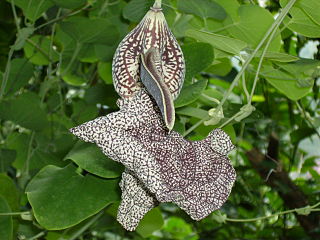Related Research Articles

Herbal teas, also known as herbal infusions and less commonly called tisanes, are beverages made from the infusion or decoction of herbs, spices, or other plant material in hot water. Oftentimes herb tea, or the plain term tea, is used as a reference to all sorts of herbal teas. Many herbs are used in herbal medicine. Some herbal blends contain actual tea.

Kava or kava kava is a crop of the Pacific Islands. The name kava is from Tongan and Marquesan, meaning 'bitter'; other names for kava include ʻawa (Hawaiʻi), ʻava (Samoa), yaqona or yagona (Fiji), sakau (Pohnpei), seka (Kosrae), and malok or malogu. Kava is consumed for its sedating effects throughout the Pacific Ocean cultures of Polynesia, including Hawaii and Vanuatu, Melanesia, some parts of Micronesia, such as Pohnpei and Kosrae, and the Philippines.

Aristolochic acids are a family of carcinogenic, mutagenic, and nephrotoxic phytochemicals commonly found in the flowering plant family Aristolochiaceae (birthworts). Aristolochic acid (AA) I is the most abundant one. The family Aristolochiaceae includes the genera Aristolochia and Asarum, which are commonly used in Chinese herbal medicine. Although these compounds are widely associated with kidney problems, liver and urothelial cancers, the use of AA-containing plants for medicinal purposes has a long history. The FDA has issued warnings regarding consumption of AA-containing supplements.

Chinese herbology is the theory of traditional Chinese herbal therapy, which accounts for the majority of treatments in traditional Chinese medicine (TCM). A Nature editorial described TCM as "fraught with pseudoscience", and said that the most obvious reason why it has not delivered many cures is that the majority of its treatments have no logical mechanism of action.

Herbal medicine is the study of pharmacognosy and the use of medicinal plants, which are a basis of traditional medicine. With worldwide research into pharmacology, some herbal medicines have been translated into modern remedies, such as the anti-malarial group of drugs called artemisinin isolated from Artemisia annua, a herb that was known in Chinese medicine to treat fever. There is limited scientific evidence for the safety and efficacy of many plants used in 21st-century herbalism, which generally does not provide standards for purity or dosage. The scope of herbal medicine sometimes include fungal and bee products, as well as minerals, shells and certain animal parts.

Ginseng is the root of plants in the genus Panax, such as Korean ginseng (P. ginseng), South China ginseng (P. notoginseng), and American ginseng (P. quinquefolius), characterized by the presence of ginsenosides and gintonin. Ginseng is common in the cuisines and medicines of China and Korea.

Petasites hybridus, also known as the butterbur, is a herbaceous perennial flowering plant in the family Asteraceae that is native to Europe and northern Asia.

Medicinal plants, also called medicinal herbs, have been discovered and used in traditional medicine practices since prehistoric times. Plants synthesize hundreds of chemical compounds for various functions, including defense and protection against insects, fungi, diseases, and herbivorous mammals.

Aristolochia is a large plant genus with over 500 species that is the type genus of the family Aristolochiaceae. Its members are commonly known as birthwort, pipevine or Dutchman's pipe and are widespread and occur in the most diverse climates. Some species, like A. utriformis and A. westlandii, are threatened with extinction.

In pharmaceutical sciences, drug interactions occur when a drug's mechanism of action is affected by the concomitant administration of substances such as foods, beverages, or other drugs. A popular example of drug-food interaction is the effect of grapefruit in the metabolism of drugs.

Silibinin (INN), also known as silybin (both from Silybum, the generic name of the plant from which it is extracted), is the major active constituent of silymarin, a standardized extract of the milk thistle, containing a mixture of flavonolignans consisting of silibinin, isosilibinin, silychristin, silidianin, and others. Silibinin itself is a mixture of two diastereomers, silybin A and silybin B, in approximately equimolar ratio. Silibinin is used in pure forms as a medication, and more frequently as an active ingredient in milk thistle–derived herbal supplements.

Cannabis tea is a cannabis-infused drink prepared by steeping various parts of the cannabis plant in hot or cold water. Cannabis tea is commonly recognized as an alternative form of preparation and consumption of the cannabis plant, more popularly known as marijuana, pot, or weed. This plant has long been recognized as an herbal medicine employed by health professionals worldwide to ease symptoms of disease, as well as a psychoactive drug used recreationally and in spiritual traditions. Though less commonly practiced than popular methods like smoking or consuming edibles, drinking cannabis tea can produce comparable physical and mental therapeutic effects. Such effects are largely attributed to the THC and CBD content of the tea, levels of which are drastically dependent on individual preparation techniques involving volume, amount of cannabis, and boiling time. Also in common with these administration forms of cannabis is the heating component performed before usage. Due to the rather uncommon nature of this particular practice of cannabis consumption in modern times as well as the legality of cannabis throughout the World, the research available on the composition of cannabis tea is limited and based broadly around what is known of cannabis as it exists botanically.

Uncaria tomentosa is a woody vine found in the tropical jungles of South and Central America. It is known as cat's claw or uña de gato in Spanish because of its claw-shaped thorns. The plant root bark is used in herbalism for a variety of ailments, and is sold as a dietary supplement.
A samskara is a process in ayurvedic medicine said to detoxify heavy metals and toxic herbs.
Stephania tetrandra is a herbaceous perennial vine of the family Menispermaceae native to China and Taiwan. It grows from a short, woody caudex, climbing to a height of around three meters. The leaves are arranged spirally on the stem, and are peltate, i.e. with the leaf petiole attached near the centre of the leaf. Its root is used in traditional Chinese medicine (TCM).

Traditional African medicine is a range of traditional medicine disciplines involving indigenous herbalism and African spirituality, typically including diviners, midwives, and herbalists. Practitioners of traditional African medicine claim, largely without evidence, to be able to cure a variety of diverse conditions including cancer, psychiatric disorders, high blood pressure, cholera, most venereal diseases, epilepsy, asthma, eczema, fever, anxiety, depression, benign prostatic hyperplasia, urinary tract infections, gout, and healing of wounds and burns and Ebola.

In herbal medicine, an herbal tonic is used to help restore, tone and invigorate systems in the body or to promote general health and well-being. An herbal tonic is a solution or other preparation made from a specially selected assortment of plants known as herbs. They are steeped in water and drunk either hot or cool. Herbal tonics are believed to have healing properties ranging from relieving muscle and joint pain and extend as far as inhibiting some cancers.
Breast enlargement supplements are frequently portrayed as being a natural means to increase breast size, and with the suggestion that they are free from risk. The popularity of breast enlargement supplements stems from their heavy promotion toward women. Though there has been historical folklore about using herbs for breast enlargement, there is no scientific evidence to support the effectiveness of any breast enlargement supplement. At times, testimonials by companies have been faked. In the United States, both the Federal Trade Commission and the Food and Drug Administration have taken action against the manufacturers of these products for fraudulent practices. The Mayo Clinic advises that there may be serious drug interactions with their use.
References
- 1 2 Talalay, P. (2001). "The importance of using scientific principles in the development of medicinal agents from plants". Academic Medicine. 76 (3): 238–247. doi: 10.1097/00001888-200103000-00010 . PMID 11242573.
- ↑ Eisenberg, D. M. (1997). "Advising patients who seek alternative medical therapies". Annals of Internal Medicine. 127 (1): 61–69. doi:10.7326/0003-4819-127-1-199707010-00010. PMID 9214254. S2CID 23351104.
- 1 2 3 4 5 6 7 8 9 10 11 12 13 14 15 16 17 18 19 20 21 22 23 24 25 26 27 28 29 30 31 32 33 34 35 36 37 38 Elvin-Lewis, M. (2001). "Should we be concerned about herbal remedies". Journal of Ethnopharmacology. 75 (2–3): 141–164. doi:10.1016/S0378-8741(00)00394-9. PMID 11297844.
- 1 2 3 4 5 6 7 8 9 10 11 12 13 14 15 16 17 "Dangerous Supplements: Twelve Supplements You Should Avoid". Consumer Reports Magazine. September 2010.
- 1 2 3 4 5 6 7 8 9 10 11 12 13 14 15 16 17 18 19 20 21 22 23 24 25 26 27 28 29 30 31 32 33 34 35 36 37 38 39 40 41 42 43 44 45 46 47 48 49 50 Ernst, E. (1998). "Harmless herbs? A review of the recent literature". The American Journal of Medicine. 104 (2): 170–178. doi:10.1016/S0002-9343(97)00397-5. PMID 9528737.
- ↑ "Betel chewing causes cancer". SciDev.
- ↑ "Aristolochia manshuriensis – Plant Finder". www.missouribotanicalgarden.org. Retrieved 6 March 2019.
- ↑ "Natural Does Not Mean Safe". Slate Magazine. 2012.
- ↑ "Aristolochic Acid: FDA Concerned About Botanical Products, Including Dietary Supplements, Containing Aristolochic Acid". FDA. 2001.
- ↑ Daniele, C.; Dahamna, S.; Firuzi, O.; Sekfali, N.; Saso, L.; Mazzanti, G. (2005). "Atractylis gummifera L. Poisoning: An ethnopharmacological review". Journal of Ethnopharmacology. 97 (2): 175–181. doi:10.1016/j.jep.2004.11.025. PMID 15707749.
- ↑ Saper, RB; Phillips, RS; Sehgal, A; Khouri, N; Davis, RB; Paquin, J; Thuppil, V; Kales, SN (27 August 2008). "Lead, mercury, and arsenic in US- and Indian-manufactured Ayurvedic medicines sold via the Internet". JAMA: The Journal of the American Medical Association. 300 (8): 915–23. doi:10.1001/jama.300.8.915. PMC 2755247 . PMID 18728265.
- 1 2 3 4 "Broom". WebMD.
- ↑ Chan, T. Y. (2001). "Interaction between warfarin and danshen (Salvia miltiorrhiza)". The Annals of Pharmacotherapy. 35 (4): 501–504. doi:10.1345/aph.19029. PMID 11302416. S2CID 20809476.
- ↑ HH, Tsai (2013). "A review of potential harmful interactions between anticoagulant/antiplatelet agents and Chinese herbal medicines". PLOS ONE. 8 (5): e64255. Bibcode:2013PLoSO...864255T. doi: 10.1371/journal.pone.0064255 . PMC 3650066 . PMID 23671711.
- 1 2 3 4 5 6 7 8 9 10 Cupp, M. J. (1999). "Herbal remedies: Adverse effects and drug interactions". American Family Physician. 59 (5): 1239–1245. PMID 10088878.
- 1 2 3 4 5 "Herbal Medicine". University of Maryland Medical Center. Archived from the original on 20 December 2017. Retrieved 1 September 2018.
- 1 2 3 4 5 6 "American Ginseng". WebMD.
- ↑ Norton, Scott A.; Ruze, Patricia (1 July 1994). "Kava dermopathy". Journal of the American Academy of Dermatology. 31 (1): 89–97. doi:10.1016/S0190-9622(94)70142-3. PMID 8021378.
- 1 2 Pantano, Flaminia; Tittarelli, Roberta; Mannocchi, Giulio; Zaami, Simona; Ricci, Serafino; Giorgetti, Raffaele; Terranova, Daniela; Busardò, Francesco; Marinelli, Enrico (16 April 2016). "Hepatotoxicity Induced by 'the 3Ks': Kava, Kratom and Khat". International Journal of Molecular Sciences. 17 (4): 580. doi: 10.3390/ijms17040580 . PMC 4849036 . PMID 27092496.
- ↑ LiverTox: Clinical and Research Information on Drug-Induced Liver Injury. National Institute of Diabetes and Digestive and Kidney Diseases. 2012. PMID 31643176.
- 1 2 3 "Peony". WebMD. Retrieved 31 December 2011.
- ↑ "Vasambu". Tamilnadu.com. 1 April 2013. Archived from the original on 22 May 2016.
- ↑ "Chamomile".
- ↑ Astragalus, NCCAM
- ↑ Heydari, Mojtaba; Mayer, Johannes Gottfried; Hashempur, Mohammad Hashem; Raee, Mohammad Javad; Ostovar, Mohadeseh; Hajimonfarednejad, Mahdie (5 April 2018). "Cinnamon: A systematic review of adverse events". Clinical Nutrition. 38 (2): 594–602. doi:10.1016/j.clnu.2018.03.013. PMID 29661513. S2CID 4942968.